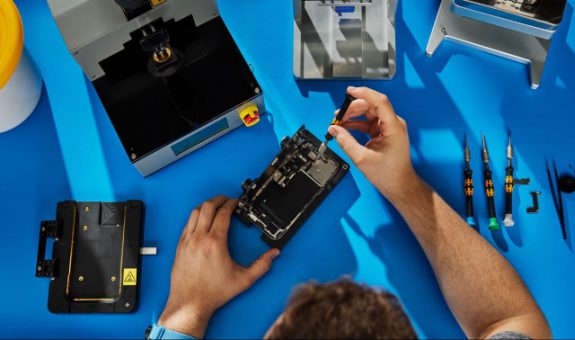

Apple has changed its repair processes in ts Self Service Repair programme to allow consumers and independent repair providers to use parts from donor devices that can be paired to the repaired product.
The parts calibration process will begin this fall with safeguards to block parts from lost or stolen devices being used.
The new process is designed to increase product longevity, and minimise the environmental impact of a repair. Used genuine Apple parts have full functionality and security of new genuine Apple parts.
“Pairing” is the process of confirming whether or not a repair part is genuine and gathering information about the part. Apple says this critical to preserving the privacy, security of the iPhone. The new policy means security-critical components parts such as Face ID and Touch ID sensors can be calibrated after the part is installed.

Future iPhone releases will have support for used biometric sensors. Customers and service providers will no longer need to provide a device’s serial number when ordering parts from the Self Service Repair Store for repairs not involving replacement of the logic board.
Apple will also extend its Activation Lock feature to iPhone parts to deter stolen iPhones from being disassembled for parts. The feature was designed to stop a lost or stolen iPhone from being reactivated. If a device under repair detects that a supported part was obtained from another device with Activation Lock or Lost Mode enabled, calibration capabilities for that part will be restricted.
Apple stated: “As device longevity increases, Apple believes it’s important that a device’s second or third owners have access to its full part and repair histories. With Parts and Service history, located within Settings on iOS, Apple is the only smartphone company that transparently shows owners whether their device has been repaired and provides information about the parts used. This fall, Apple will expand Parts and Service History to additionally show whether a part is a new or used genuine Apple part.
“This upcoming enhancement to Apple’s repair processes is another step forward in the company’s commitment to improving access to safe and affordable repairs.
Self Service Repair was launched two years ago to gives access to manuals, genuine Apple parts, and tools used at Apple Store and Apple Authorised Service Provider locations. It covers 40 Apple products in 33 countries and regions, and 24 languages.
In the last five years, Apple has nearly doubled the number of service locations with access to genuine Apple parts, tools, and training to more than 10,000 Independent Repair Providers and Apple Authorised Service Providers.
Anisha Bhatia, Senior Technology analyst at data and analytics company GlobalData commented.
“Apple’s enhancement of its repair process to utilise used Apple parts is a win for the Right to Repair movement, while still allowing the tech giant to maintain control over repair revenues.
“Apple is simplifying its repair process for both customers and service providers by doing away with its cumbersome parts pairing feature, for iPhone 15 series and newer phones. This will eliminate the need to provide a device’s serial number when ordering parts, making iPhone repair less bothersome which in turn will increase circular economy income for the tech giant.
“OEMs have come under pressure by governments as the Right to Repair movement has gained tremendous momentum in the EU and the US. The EU passed its own ‘Right to Repair’ law in February 2024, and various repair bills have passed in four US states, with more right- to- repair bills being debated in legislatures across 28 other US states. Sustainability is a hot button topic right now, and sustainable devices with increased longevity potential are likely to generate brand loyalty for both telcos and OEMs that offer it as a differentiator.”







